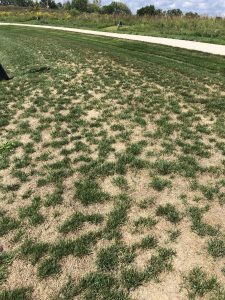By Vijai Pandian, Horticulture Educator
After a stressful summer, lawn grasses in Wisconsin rejuvenate in autumn. Fall is considered one of the best times to seed, renovate and establish new lawns. Moderate temperatures in the 70s and ample soil moisture in September promote the speedy establishment of lawn grasses. Summer annual weeds like crabgrass end their life cycle in September and don’t compete with the newly seeded grass.
The first step in lawn renovation is to identify the cause of lawn decline and assess the spread of damaged areas. This year’s summer heat and drought stress caused multiple bare patches and thin lawns in southeast Wisconsin. Compacted soil, chinch bugs, shade, lack of fertility, and diseases (necrotic ring spot, summer patch) can also further stress the grasses in the summer months. Lawns with more than 50% desirable grasses, can be renovated by over-seeding bare patches. However, lawns that have more than 50% weeds or bare ground require a complete renovation.
Following are some useful tips in over-seeding an established lawn:
- Start by selecting the right seed mix for the given site. For sunny areas, use 50-100% Kentucky bluegrass mix and for dry shaded sites use 50% or more with fine fescue mix.
- Take control of perennial weed patches like Creeping Charlie, by using broadleaf weed control products containing triclopyr as an active ingredient. Follow the label directions for safety and direction. Schedule a second application at about 10-14 days interval for effective control.
- Small bare patches about the size of baseball may require some fertilizer. Broadcast the bare area with general lawn fertilizer (1lb of Nitrogen per 1000 square feet rate) to boost the surrounding turf grasses to fill in the voids.
- To fix dead patches about the size of basketball, loosen the soil, sprinkle the right type of seeds by hand and rake the seeds gently to a depth of ¼ to 3/8 inch.
- To over-seed larger areas or to improve turf density, rent a slit seeder from a local hardware store or garden centers. You can also seek service from professional lawn care companies to slit seed your lawn. Slit seeders make a small groove in the soil and deposit the seeds. The flap attached at the back end of the slit seeder covers the deposited seed with soil. Run the slit seeder at two perpendicular directions to each other using half the seeding rate to get a uniform dense lawn growth.
- It is important to irrigate, mow and fertilize the over-seeded area for successful establishment. Keep the over-seeded area moist until it is established. Use a clean straw to mulch it lightly (one bale per 1000 square feet). Begin mowing when the seedlings reach 3 inches tall (takes about 3-6 weeks) and fertilize six weeks after germination with general lawn fertilizer.
For any garden inquiries click the link below.




